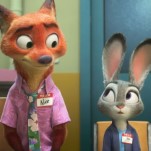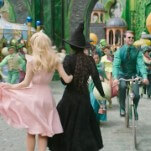Tragedy Girls

Horror comedy isn’t a novelty act, but Tyler MacIntyre’s Tragedy Girls sure treats it like one. Maybe blame Ryan Murphy: Back in 2014, he tried to take credit for inventing the term while doing press for Scream Queens, blithely mashing words together as though Abbott and Costello had never met Frankenstein. Now, horror-comedy is less about harmony between jokes and jugular spray than about winking at your audience, nudging them until they’re bruised on their sides, and going out of your way to let everyone know that you’re hip to horror’s antecedents. (Let’s blame Scream for that, too, but Scream at least was watchable.)
Tragedy Girls is a movie in that eagerly referential vein, name-dropping greats like Dario Argento both for the sake of street cred and dad-level humor: Kayla (Alexandra Shipp) butchers his name as casually as she butchers her classmates, not once but twice in a row, when confronted by Jordan (Jack Quaid), the clean-cut nice guy crushing on her BFF, Sadie (Brianna Hildebrand). “Dario DiGiorno. Dario Arpeggio. Mario Wario.” Jordan just wants to give Sadie an alibi to keep his sheriff father (Timothy V. Murphy) off her case after the latest bloody murder at their high school. Kayla, in an exchange that perfectly exemplifies Tragedy Girls’ surface level interest in the movies it purports to be about, doesn’t care. “Byesies!”
Jordan, of course, is unaware that Kayla and Sadie are the people responsible for the murdering; he just wants to protect Sadie from unfair (but actually totally fair) suspicion. She and Kayla run a joint Instagram feed, @TragedyGirls, where they speculate on local-area killings committed by the town maniac, Lowell (Kevin Durand), your prototypical hulking masked maniac. Truthfully, it’s all a front for their own obsession with serial killing, which they hope to make into a side gig as a means of attaining popularity. To achieve their ends, they kidnap Lowell in a frankly idiotic attempt at convincing him to mentor them. Hilarious gore ensues, assuming your idea of hilarity consists of watching narcissistic teens hack up considerably more likable, or at least inoffensive, characters.
The film works best when Kayla and Sadie mess up. They don’t really know what they’re doing, hence Lowell, and their ignorance in the ways of savage but stealthy murderin’ leads to botched kills. People die, for sure, but Final Destination-style. One girl somehow ends up upside down, suspended by her ankle from a chain that swings her face-first into a live table saw. Ouch, and also ick. The better the girls get at intentionally offing people, though, the more noxious that Tragedy Girls becomes. Their victims never quite hit the threshold necessary to make us wish for their deaths, for one thing, and for another, Kayla and Sadie represent the me-focused moment we’re living in. Like Matt Spicer’s Ingrid Goes West, Tragedy Girls is about the addictive, self-oriented evils of social media, but filtered through a slasher lens. “Look at what the quest for Internet fame turns these people into,” the film tells us. “Look at how gosh darn egomaniacal they are! Also, murder-happy.”
-

-

-

-

-

-

-

-

-

-

-

-

-

-

-

-

-

-

-

-

-

-

-

-

-

-

-

-

-

-

-

-

-

-

-

-

-

-

-

-








































